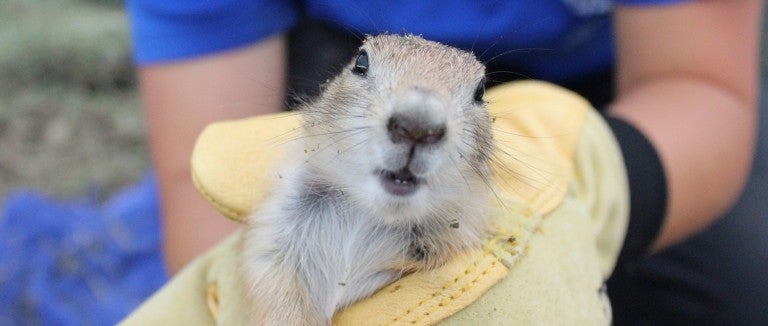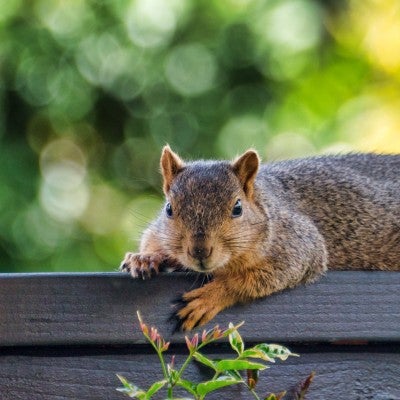Prairie dogs are one of the most controversial and widely misunderstood wildlife species in North America. Since early European migration onto the North American grasslands, prairie dogs have been celebrated as an essential keystone species for healthy grasslands ecosystems, but also vilified and, in some locations, managed as destructive rodent pests. Human-caused changes to the grasslands stemming from crop agriculture, livestock grazing, energy development, residential and commercial development, prairie dog shooting, poisoning campaigns and plague (an introduced disease) have caused the five species of prairie dogs to disappear from an estimated 87-99% of their historic (1800s) range, depending on the species.
Though prairie dog habitat has decreased tremendously and their numbers have dwindled dramatically, people are still trying to wipe out these highly social creatures. For some, prairie dogs can present challenges as their burrow mounds and colonies use the same space as crops and can make grasslands difficult to navigate for livestock. Because prairie dogs also eat grass, ranchers and farmers view them as a threat to their livelihoods. Common methods used to remove prairie dog colonies include shooting, poisoning, contest kills and even bulldozing when they face a developer’s path in the urban areas.
Organized shoots on public lands kill large numbers of prairie dogs in a single day and negatively affect the social structure and health of the colony for years to come. Over 150 wildlife species including hawks, eagles, songbirds, foxes and even nematodes are associated with prairie dog colonies. Prairie dogs are like the canary in the coal mine—what happens to them is happening to other animals on the prairie.
Conflict reduction plans and coexistence offer a more wildlife friendly and humane solution to issues that arise for both wildlife and people.
Creating prairie dog management plans: A guide for local governments and stakeholders
- Part 1: Background and context [PDF]
- Part 2: The management plan [PDF]
- Part 3: Appendices and attachments [PDF]
Building understanding and tolerance
Sometimes the damage that animals actually do is much less than believed and sometimes what some see as "damage" is actually a benefit that goes unappreciated.
Recent studies on the overall ecological benefits of prairie dogs suggest that their critical role in encouraging biological diversity has been overlooked. For example, many folks don’t like the looks of dirt patches on prairie dog colonies, but those dirt patches are the perfect camouflage place for the mountain plover (a songbird in decline) to build a nest and lay their eggs.
Additionally, it's hard for some folks to give up a grassy looking turf. Prairie dogs clipping and digging activities create more small shrubs and forb plants and less grass sometimes. This creates more biodiverse and healthy habitat even though it may not look the way some of us want it to.
Many grazing animals, including domestic cattle, prefer to graze within prairie dog towns. Interestingly, prairie dogs prefer to build their colonies in areas that have been overgrazed since the low vegetation allows a clear view of potential predators.

Modify the habitat
You can change landscaping to increase or decrease cover or available food or to encourage predators. Before making major landscaping changes, determine what species of prairie dog is on your property and do a little research on its preferred habitat. Black-tailed prairie dogs, for instance, actively clear vegetation so they can see predators from a distance. If you create a visual barrier along the edge of a colony, thereby blocking the line of sight, you can effectively limit the spread of the colony or even force an existing colony to relocate.
Barriers
Creating visual and physical barriers can be really effective. It may not be 100%, but it’s a tool we can certainly work with; barriers and buffer zones can be made of many materials:
- Vinyl barrier fencing
- Snow fencing
- Wood-slatted privacy fencing
- Hay balestall sturdy plants
- Fast-growing tall grasses
- Shrubs
- Trees
- Electric fencing to keep livestock out of 90’-wide zones
Establishing vegetative barriers and buffers may mean new plantings or simply allowing existing plant life in grassy areas to become taller and denser by mowing and clipping less often. Because black-tailed prairie dogs will actually clip plants that are taller than their preferred height, you may want to begin with vinyl barrier fencing or hay bales with tall plants planted behind them. The hay-bale will break down over a few years, but by then, the tall plants will be established and difficult for prairie dogs to clip down.
Tolerate predators
Once you understand the role native predators can play in helping to reduce prairie dog colony size, you may want to tolerate their presence in order to set up a natural balance that will reduce your problems.
To attract raptors—such as hawks, owls and kestrels—you can provide suitable-sized nesting boxes and artificial perching sites near the colony.
Prairie dogs and plague
Prairie dogs can carry fleas with a bacterium known as yersinia pestis: Yersinia is the bacteria that causes sylvatic plague in an animal, including prairie dogs. Research has shown that "dusting" colonies with insecticides such a deltamethrim (delta dust) or pyraperm not only kills fleas but may also stop the outbreak of this exotic disease in colonies that have already been infected.
Additional resources
- Prairie dog barriers: An overview [PDF]
- Reverse dispersal translocation [PDF]
- Prairie dog action pack [PDF]
- Prairie dogs, people and plague: A report collated by the Prairie Dog Coalition, HSUS and the Colorado CDC [PDF]
- USGS: Sylvatic plague vaccine and management of prairie dogs [PDF]
- USGS: Ecology of plague
- CDC: Protect yourself from plague [PDF]

